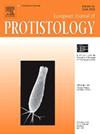不是Lycogala?紫石蒜的全型研究
IF 1.6
2区 生物学
Q4 MICROBIOLOGY
引用次数: 0
摘要
粘菌Lycogala fuscoviolaceum是P. Onsberg于1972年根据在尼泊尔采集的单个标本描述的。这个物种的地位仍然不明确,因为自描述以来没有其他发现报告。在这项研究中,我们重新检查了保存在哥本哈根的全型,以确定fuscoviolaceum的真实系统位置。形态学观察显示与Lycogala不一致的特征,包括致密的软骨皮质,形成垂直束的假毛细体,以及厚壁的孢子和细长的孔。这些特征表明,L. fuscoviolaceum可能是网纹菌科(Reticularia)的一员,可能与网纹菌(Siphoptychium)有亲缘关系,或者根本不是黏菌。对褐堇菜皮质结构的横切面分析显示,存在分层排列的细胞样成分。这些元素在锦绣、网纹和紫罗兰中不存在,但在黄草中存在。由于DNA降解,试图从L. fuscoviolaceum的全型中获得分子数据,包括短片段的高通量测序,均未成功。需要新的发现来澄清该物种的分类地位。本文章由计算机程序翻译,如有差异,请以英文原文为准。
Not a Lycogala? Investigating the holotype of Lycogala fuscoviolaceum
The myxomycete Lycogala fuscoviolaceum was described by P. Onsberg in 1972 based on a single specimen collected in Nepal. The status of this species remains ambiguous, as no additional findings have been reported since its description. In this study, we re-examined the holotype stored in Copenhagen to determine the true systematic position of L. fuscoviolaceum. Morphological observations revealed features inconsistent with Lycogala, including the dense, cartilaginous cortex, the pseudocapillitium forming vertical bundles, and the thick-walled spores with elongated pore. These characteristics suggest that L. fuscoviolaceum is either a member of the family Reticulariaceae, possibly related to Reticularia or Siphoptychium, or it is not a myxomycete at all. Cross-sections of the cortical structures of L. fuscoviolaceum revealed the presence of cell-like elements arranged in distinct layers. Such elements were absent in Reticularia splendens, Siphoptychium reticulatum, and S. violaceum, but present in L. flavofuscum. Attempts to obtain molecular data from the holotype of L. fuscoviolaceum, including high-throughput sequencing of short fragments, were unsuccessful due to DNA degradation. New findings are required to clarify the taxonomic position of the species.
求助全文
通过发布文献求助,成功后即可免费获取论文全文。
去求助
来源期刊

European journal of protistology
生物-微生物学
CiteScore
4.60
自引率
20.70%
发文量
55
审稿时长
14.6 weeks
期刊介绍:
Articles deal with protists, unicellular organisms encountered free-living in various habitats or as parasites or used in basic research or applications. The European Journal of Protistology covers topics such as the structure and systematics of protists, their development, ecology, molecular biology and physiology. Beside publishing original articles the journal offers a forum for announcing scientific meetings. Reviews of recently published books are included as well. With its diversity of topics, the European Journal of Protistology is an essential source of information for every active protistologist and for biologists of various fields.
 求助内容:
求助内容: 应助结果提醒方式:
应助结果提醒方式:


